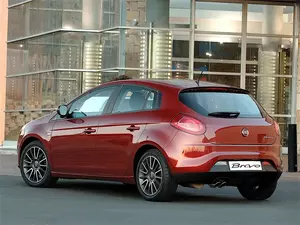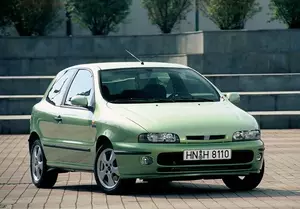
| Vehicle | Curb weight | Difference from world's smallest | Weight to power ratio | 0—60 mph acceleration ratio | Consumption ratio |
|---|---|---|---|---|---|
| 1.4 MultiAir |
1275 kg / 2811 lbs |
850 kg (1874 lbs) heavier | 9 kg to 1 hp | 150 kg/s (331 lbs/s) |
224 kg/L (494 lbs/L) |
| 1.4 |
1205 kg / 2657 lbs |
780 kg (1720 lbs) heavier | 13 kg to 1 hp | 101 kg/s (223 lbs/s) |
180 kg/L (397 lbs/L) |
| 1.4 T-Jet |
1260 kg / 2778 lbs |
835 kg (1841 lbs) heavier | 11 kg to 1 hp | 138 kg/s (304 lbs/s) |
188 kg/L (415 lbs/L) |
| 1.9 MultiJet |
1360 kg / 2999 lbs |
935 kg (2062 lbs) heavier | 9 kg to 1 hp | 158 kg/s (348 lbs/s) |
243 kg/L (536 lbs/L) |
| 1.6 Multijet |
1320 kg / 2911 lbs |
895 kg (1974 lbs) heavier | 15 kg to 1 hp | 108 kg/s (238 lbs/s) |
300 kg/L (662 lbs/L) |
| 2.0 Multijet |
1360 kg / 2999 lbs |
935 kg (2062 lbs) heavier | 8 kg to 1 hp | 174 kg/s (384 lbs/s) |
257 kg/L (567 lbs/L) |
| Vehicle | 1.4 MultiAir |
|---|---|
| Curb weight |
1275 kg / 2811 lbs |
| Difference from world's smallest | 850 kg (850 lbs) heavier |
| Weight to power ratio | 9 kg to 1 hp |
| 0—60 mph acceleration ratio | 150 kg/s (331 lbs/s) |
| Consumption ratio |
224 kg/L (494 lbs/L) |
| Vehicle | 1.4 |
| Curb weight |
1205 kg / 2657 lbs |
| Difference from world's smallest | 780 kg (780 lbs) heavier |
| Weight to power ratio | 13 kg to 1 hp |
| 0—60 mph acceleration ratio | 101 kg/s (223 lbs/s) |
| Consumption ratio |
180 kg/L (397 lbs/L) |
| Vehicle | 1.4 T-Jet |
| Curb weight |
1260 kg / 2778 lbs |
| Difference from world's smallest | 835 kg (835 lbs) heavier |
| Weight to power ratio | 11 kg to 1 hp |
| 0—60 mph acceleration ratio | 138 kg/s (304 lbs/s) |
| Consumption ratio |
188 kg/L (415 lbs/L) |
| Vehicle | 1.9 MultiJet |
| Curb weight |
1360 kg / 2999 lbs |
| Difference from world's smallest | 935 kg (935 lbs) heavier |
| Weight to power ratio | 9 kg to 1 hp |
| 0—60 mph acceleration ratio | 158 kg/s (348 lbs/s) |
| Consumption ratio |
243 kg/L (536 lbs/L) |
| Vehicle | 1.6 Multijet |
| Curb weight |
1320 kg / 2911 lbs |
| Difference from world's smallest | 895 kg (895 lbs) heavier |
| Weight to power ratio | 15 kg to 1 hp |
| 0—60 mph acceleration ratio | 108 kg/s (238 lbs/s) |
| Consumption ratio |
300 kg/L (662 lbs/L) |
| Vehicle | 2.0 Multijet |
| Curb weight |
1360 kg / 2999 lbs |
| Difference from world's smallest | 935 kg (935 lbs) heavier |
| Weight to power ratio | 8 kg to 1 hp |
| 0—60 mph acceleration ratio | 174 kg/s (384 lbs/s) |
| Consumption ratio |
257 kg/L (567 lbs/L) |

| Vehicle | Curb weight | Difference from world's smallest | Weight to power ratio | 0—60 mph acceleration ratio | Consumption ratio |
|---|---|---|---|---|---|
| 1.6 16V |
1025 kg / 2260 lbs |
600 kg (1323 lbs) heavier | 10 kg to 1 hp | 98 kg/s (216 lbs/s) | - |
| 1.2 16V 80 |
985 kg / 2172 lbs |
560 kg (1235 lbs) heavier | 12 kg to 1 hp | 83 kg/s (183 lbs/s) | - |
| 1.4 |
1010 kg / 2227 lbs |
585 kg (1290 lbs) heavier | 13 kg to 1 hp | 77 kg/s (170 lbs/s) |
142 kg/L (313 lbs/L) |
| 1.8 GT |
1100 kg / 2426 lbs |
675 kg (1489 lbs) heavier | 10 kg to 1 hp | 116 kg/s (256 lbs/s) |
124 kg/L (273 lbs/L) |
| 1.9 JTD 105 |
1145 kg / 2525 lbs |
720 kg (1588 lbs) heavier | 11 kg to 1 hp | 116 kg/s (256 lbs/s) | - |
| 1.9 TD 100 S |
1155 kg / 2547 lbs |
730 kg (1610 lbs) heavier | 12 kg to 1 hp | 112 kg/s (247 lbs/s) |
180 kg/L (397 lbs/L) |
| 1.9 TD 75 S |
1120 kg / 2470 lbs |
695 kg (1533 lbs) heavier | 15 kg to 1 hp | 78 kg/s (172 lbs/s) | - |
| 2.0 HGT 20V |
1190 kg / 2624 lbs |
765 kg (1687 lbs) heavier | 8 kg to 1 hp | 147 kg/s (324 lbs/s) |
134 kg/L (295 lbs/L) |
| 1.9 JTD 100 |
1145 kg / 2525 lbs |
720 kg (1588 lbs) heavier | 11 kg to 1 hp | 116 kg/s (256 lbs/s) |
212 kg/L (467 lbs/L) |
| Vehicle | 1.6 16V |
|---|---|
| Curb weight |
1025 kg / 2260 lbs |
| Difference from world's smallest | 600 kg (600 lbs) heavier |
| Weight to power ratio | 10 kg to 1 hp |
| 0—60 mph acceleration ratio | 98 kg/s (216 lbs/s) |
| Consumption ratio | - |
| Vehicle | 1.2 16V 80 |
| Curb weight |
985 kg / 2172 lbs |
| Difference from world's smallest | 560 kg (560 lbs) heavier |
| Weight to power ratio | 12 kg to 1 hp |
| 0—60 mph acceleration ratio | 83 kg/s (183 lbs/s) |
| Consumption ratio | - |
| Vehicle | 1.4 |
| Curb weight |
1010 kg / 2227 lbs |
| Difference from world's smallest | 585 kg (585 lbs) heavier |
| Weight to power ratio | 13 kg to 1 hp |
| 0—60 mph acceleration ratio | 77 kg/s (170 lbs/s) |
| Consumption ratio |
142 kg/L (313 lbs/L) |
| Vehicle | 1.8 GT |
| Curb weight |
1100 kg / 2426 lbs |
| Difference from world's smallest | 675 kg (675 lbs) heavier |
| Weight to power ratio | 10 kg to 1 hp |
| 0—60 mph acceleration ratio | 116 kg/s (256 lbs/s) |
| Consumption ratio |
124 kg/L (273 lbs/L) |
| Vehicle | 1.9 JTD 105 |
| Curb weight |
1145 kg / 2525 lbs |
| Difference from world's smallest | 720 kg (720 lbs) heavier |
| Weight to power ratio | 11 kg to 1 hp |
| 0—60 mph acceleration ratio | 116 kg/s (256 lbs/s) |
| Consumption ratio | - |
| Vehicle | 1.9 TD 100 S |
| Curb weight |
1155 kg / 2547 lbs |
| Difference from world's smallest | 730 kg (730 lbs) heavier |
| Weight to power ratio | 12 kg to 1 hp |
| 0—60 mph acceleration ratio | 112 kg/s (247 lbs/s) |
| Consumption ratio |
180 kg/L (397 lbs/L) |
| Vehicle | 1.9 TD 75 S |
| Curb weight |
1120 kg / 2470 lbs |
| Difference from world's smallest | 695 kg (695 lbs) heavier |
| Weight to power ratio | 15 kg to 1 hp |
| 0—60 mph acceleration ratio | 78 kg/s (172 lbs/s) |
| Consumption ratio | - |
| Vehicle | 2.0 HGT 20V |
| Curb weight |
1190 kg / 2624 lbs |
| Difference from world's smallest | 765 kg (765 lbs) heavier |
| Weight to power ratio | 8 kg to 1 hp |
| 0—60 mph acceleration ratio | 147 kg/s (324 lbs/s) |
| Consumption ratio |
134 kg/L (295 lbs/L) |
| Vehicle | 1.9 JTD 100 |
| Curb weight |
1145 kg / 2525 lbs |
| Difference from world's smallest | 720 kg (720 lbs) heavier |
| Weight to power ratio | 11 kg to 1 hp |
| 0—60 mph acceleration ratio | 116 kg/s (256 lbs/s) |
| Consumption ratio |
212 kg/L (467 lbs/L) |